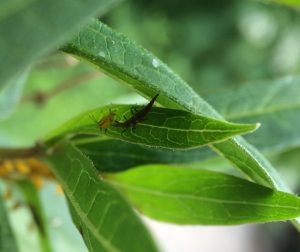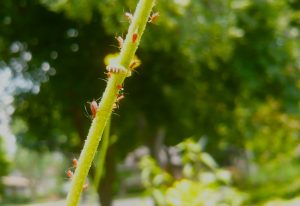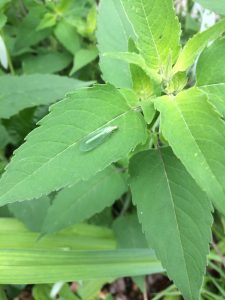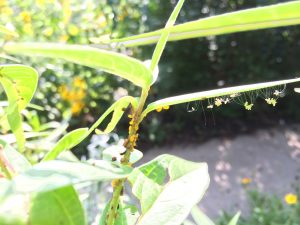
This post was written to address a question about aphids on milkweed. Any of the steps would apply to aphids on any other type of plant, including edibles. (Note the image at the top of the page is of a Lacewing adult, one of the beneficials that you want to attract and keep in your garden.)
Do Nothing
The best thing to do is to do nothing–if you can stand it. Eventually, beneficial insects will find the aphids and begin to control if not completely decimate the aphid population. Often we are told to squish (this writer has done that) or to blast them with a hose (also done that).
The best time to squish or hose off would be right at first sign of aphids and keep it up before predators find them. If you have a large aphid infestation and use the hose/squish methods, the aphids will certainly be gone, but you might also be washing away their predators.
Once you can identify the beneficial insects and know that they are not present, you can wash away aphids away in confidence, knowing that you are not harming Monarch or beneficial insects. It’s equally important to learn about these natural predators and how to support all stages of their life cycles so that they can keep aphids in check as soon as they arrive. Be sure to check for caterpillars and eggs first though too. Hatchling caterpillars are very tiny and fragile.
No Need to Shop for Beneficial Insects
No need to order or buy adult ladybugs (they usually fly away and may negatively impact native ladybug populations). It’s better to wait for reinforcements, which will be sooner if you didn’t do extensive garden clean-up in the fall/spring and a little later if you did do a lot of clean-up because they will have to migrate in from elsewhere. Arriving in short order will be other allies too–Soldier Beetles, Ladybugs, Lacewing larvae, parasitoid wasps, predatorial wasps, Minute Pirate Bugs, Whirlygig Mites, Long-legged Flies, Earwigs (!–yes they are aphid predators) and Syrphid Fly larvae. All of these and other predators will dine on the aphids too. (Pictures of some of these found below.)
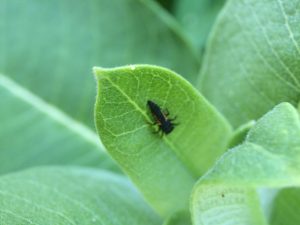
Have Milkweed Back-up
It’s All About Community
Plant a lot of native plants to support lots of insects that eat plants, and the predators will be around consistently, including parasitic wasps. f you have many native plants, trees, bushes that support a lot of herbivorous insects, you will keep the wasps busy and perhaps reduce pressure off of the butterfly caterpillars. So, for instance if you only grow milkweed and some zinnias and non-native perennials, which don’t support any other caterpillar, the wasps and yellow jackets have no other option but to go after the Monarch caterpillars, and you can’t keep the wasps out of your yard.
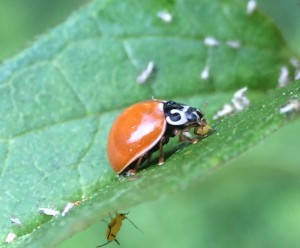
Importance of Garden Clean-up
An important but overlooked piece of information is that many of our beneficials like ladybugs, lacewings, syrphid flies, soldier beetles, etc., are year round inhabitants in our gardens. They overwinter in the garden. After planting native plants, another important strategy is to change our fall and spring clean-up practices.
Some of the insects that prey upon aphids might also prey upon small Monarch instars. If you find young caterpillars, you can simply move them to another milkweed plant that is aphid-free.
